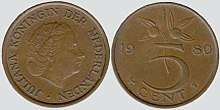Stuiver
The stuiver [stœy.vər] was a pre-decimal coin used in the Netherlands. It was worth 16 penning or 8 duit. Twenty stuivers equalled a guilder. It circulated until the Napoleonic Wars. After the conflict, the Netherlands decimalised its guilder into 100 cents. Two stuivers equalled a dubbeltje - the ten-cent coin.[1][2]
| Value | 0.05 Dutch guilder |
|---|---|
| Mass | 3.5 g |
| Diameter | 21 mm |
| Thickness | 1.45 mm mm |
| Edge | plain |
| Orientation | coin |
| Composition | 95% Cu, 4% Sn, 1% Zn |
| Years of minting | 1948–2001 (Utrecht) |
| Circulation | 1948– 28 January 2002 Redeemed by national bank until 1 January 2007 |
| Catalog number | - |
| Obverse | |
 | |
| Design | Queen Wilhelmina (1948) Queen Juliana (1950–1980) Queen Beatrix (1982–2001) |
| Designer | L. O. Wenckebach (1948–1980) Bruno Ninaber van Eyben (1982–2001) |
| Reverse | |
 | |
| Design | Face value, year, privy mark (left), mint mark (right) |
| Designer | L. O. Wenckebach (1948–1980) Bruno Ninaber van Eyben (1982–2001) |
After the decimalisation of Dutch currency, the name "stuiver" was preserved as a nickname for the five-cent coin until the introduction of the euro. The word can still refer to the five euro cent coin, which has almost exactly the same diameter and colour despite being over twice the value of the older coin. The English denomination name stiver (used in colonial Sri Lanka and Guyana) is derived from stuiver.
Stuivers of the Dutch East India Company
From 1660, the Dutch East India Company began to strike copper stuiver coins for local use in Sri Lanka. At first, the coins were simply stamped on both sides with their denomination but from 1783, the VOC monogram and date were added. The coins were minted at Colombo, Jaffna, Galle and Trincomalee. These coins were issued till British occupation in 1796.
Kingdom of the Netherlands
The Five cent coin struck in the Kingdom of the Netherlands between 1818 and 2001 was also called Stuiver.[3]
Euro
The Euro five cent coin continues to be referred to as stuiver in the contemporary Netherlands.[4][5][6]
See also
- 5 Cent WWII (Dutch coin)
- 5 Cent 1948 (Dutch coin)
References
- "Geschiedenis van de gulden". KNM.
- Van Gelder, Hendrik Enno (22 November 2017). Geschiedenis van de stuiver, door Dr. H. Enno Van Gelder. OCLC 458375109.
- "nomisma.nl". Retrieved 2014-05-17.
- "Stuiver".
- "De Telegraaf-i [] Alles over de euro". krant.telegraaf.nl.
- "Oranje: Van geen stuiver waard naar euro-forisch - VoetLicht Media". 6 July 2014.